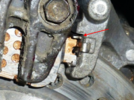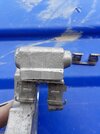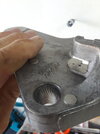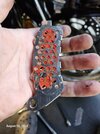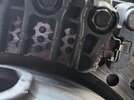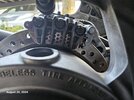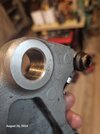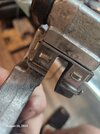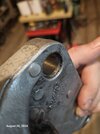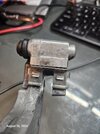The SMC is supposed to be raised so that the cylinder is anywhere between 0 degrees and 15 degrees. The idea is that any air in that cylinder cannot float to the plunger (left hand) end of the piston. It needs to flow out of the outlet valve - it can then escape when you open up the PCV bleed valve near the left hand igntion coil.
The front master cylinder - by which I assume that you mean the brake lever on the right hand handlebars - operates only on the two outer pistons on each of the front calipers. Once that is bled and your lever feels firm - there is nothing more to do with that. That circuit is hydraulically separate from the complex rear master cylinder and SMC circuit.
This article that I produced has a series of diagrams which show and explain the fluid flow. It is a good aid to understanding the hydraulics.
A detailed look at the process of getting the air out of the Honda ST1300 brake lines. A sequence of diagrams of the brake circuits, colour coded to show which parts of the system are being accessed when each bleed valve is opened and explanations of where the trouble spots are. These are just...

www.st-owners.com
Having air in the system isn't going to cause your brakes to drag. Ever.
Pumping fluid through the system with the rear brake pedal works well, but also when the SMC is tilted and the PCV bleed valve is open, it is good practice to pump the SMC back and forth. You get a feel for how well it is pumping; you can get a full stroke of the piston which helps to clear out any old fluid (It normally only moves a coumple of mm); and you can feel if there is any drag or obstruction inside the bore. When pushed so that the plunger is in a direct line, the movement should be smooth. If you tilt the plunger - it is possible that the piston will be tilted and catch on the cylinder bore. But you have replaced the entire SMC - so that shouldn't be an issue.
Pumping the front lever should not cause the front wheel to drag. The pistons should release when you let go of the lever. It certainly will not affect the rear brake.
Is the drag just at the rear wheel or at the front as well ?
We need to isolate the cause of the drag. Is it the brake pads, the calipers, the bearings or the wheel fitment that is causing the drag. That isn't a question for you to answer on here, it is what you need to find out for yourself.
Remove the pads. Check for wheel rotation without the pads in place. IT isn't going to get better than that - but if the wheel isn't rotating, that needs to beaddressed first !
If the wheel rotates without the pads in place then Possible causes include: Incorrectly seated pad spring, incorrect chrome retaining clip (front and rear are different); incorrect pads fitted (eg front pads used in rear) - the pads you showed were not Handa pads - possibly EBC - The fit has been reported to be inconsistent; Location of pads in relation to the tag on the pad spring is wrong; pad pins are cross threaded and not parallel; .....
While you have the pads out, check how easily the calipers move into and away from the wheel. Grab a handful and push it in. You should be able to move the caliper all the way in so that the pistons touch the brake disk/rotor, and (I think) it should pull all the way back so that the rear side of the caliper touches the rotor. (Just watch out for grease on the caliper getting onto your brake disks). Pause after each movement - see if the caliper starts to return by itself. Also be aware that it is possible for the pad pins - on which the caliper slides - to be bent or not parallel. If this is the case, the caliper will move easily initially and then it will resist further movement.
If you think that it is the pads/pistons - then the next thing is to find out which and why. Rear pedal operates all three pistons on the rear. Centre pistons on the front. The SMC operates just the two outer pistons on the rear. Strips of paper or feeler guages. held in place when the brake pedal is applied - should be easy to remove when pressure is released. This can be used to identify pistons that are stuck.
Be very careful when you have the pads out that you do not apply the brake pedals or levers. Popping a piston and all of its fluid is a pain.
Read the link that I posted in my previous post - Avoiding the pitfalls. Anything that you don't understand, ask. I wrote it a long time back and a lot of people have learned a lot from it - probably noone more than me ! That covers most things.
Which model ST1300 do you have ? (It'll be on the white label on the frame under the seat). eg ST1300 A9). The brakes changed in 2008.

